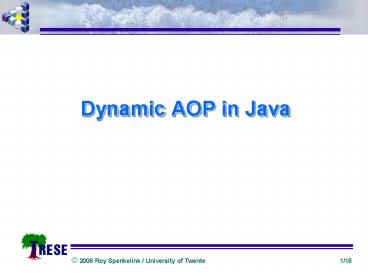Dynamic AOP in Java - PowerPoint PPT Presentation
1 / 16
Title:
Dynamic AOP in Java
Description:
2006 Roy Spenkelink / University of Twente. Dynamic AOP. Adding/removing aspects during runtime ... Enhancer Proxy. Inheritance instead of aggregation. 9 /16 ... – PowerPoint PPT presentation
Number of Views:247
Avg rating:3.0/5.0
Title: Dynamic AOP in Java
1
Dynamic AOP in Java
2
Overview
- Dynamic AOP
- Domain Analysis
- Proxy based
- Bytecode manipulation
- Interpreter based
- Final Remarks
3
Dynamic AOP
- Adding/removing aspects during runtime
- Can help avoid
- Re-compiling
- Re-deployment
- Re-start of an application
- More flexible than static weaving
4
Domain Analysis
- 3 main approaches
- Proxy based
- Nanning, Spring, Jeet, dynaop
- Bytecode manipulation
- AspectWerkz, JBossAOP, JAC, Wool
- Bytecode manipulation tools
- Javassist, BCEL, ASM
- Interpreter based
- Plugins/Extensions Prose, Axon
- JVM-level AOP JRockit
5
Proxy-based (1/4)
- Proxy
- A proxy is a surrogate or placeholder for a
target object to control access to it. (Proxy
pattern)
6
Proxy based (2/4)
- Creating proxies dynamically
- JDK java.lang.reflect.Proxy
7
Proxy-based (3/4)
8
Proxy-based (4/4)
- What if we want to advice classes that dont have
interfaces? - CGLIB
- Code Generation Library / API
- Transforms classes into classes
- ASM
- Similar to JDK dynamic proxies
- MethodInterceptor InvocationHandler
- Enhancer Proxy
- Inheritance instead of aggregation
9
Bytecode Manipulation (1/3)
- Bytecode manipulation tools
- BCEL, Javassist, ASM
- Most popular of the 3 approaches
- AspectWerkz, JBossAOP, JAC, Wool
- Some drawbacks
- Performance CPU-intensive
- Scalability 64kb boundary for class files
10
Bytecode manipulation (2/3)
- HotSwap
- Changing method/constructor bodies of classes at
runtime and inject them into a running JVM - Fixed schema
- Preparation step is needed
- Part of JVMTI since Java 5
- java.lang.instrument
11
Bytecode manipulation (3/3)
- Comparison BCEL, Javassist, ASM
- ASM much faster
- gt5 times faster than Javassist/BCEL
- Javassist easiest to use
- source code level instrumentation
- lower learning curve than bytecode
instrumentation
12
Interpreter-based
- Based on intercepting execution events in the JVM
- Adapting the JVM
- Plugins/Extensions
- Prose, Axon
- New JVM
- JRockit
13
Interpreter based Prose (1/2)
14
Interpreter-based Prose (2/2)
- Limitations
- No introductions (cannot change the original
code) - Slow because of Debugger overhead
- Small public
15
Interpreter-based
- AOP support built in the JVM
- JRockit
- Prototype / not standardized
- Advantages vs bytecode instrumentation
- No startup-cost due to bytecode instrumentation
- No double bookkeeping building a class DB
- Support for intercepting reflective calls
16
Final Remarks
- Some insight given in different techniques that
can be used to handle dynamic AOP in Java - Proxy, bytecode manipulation / HotSwap,
interpreter-based - Work this out
- Probably using bytecode manipulation
- Javassist , HotSwap
- Also combinations are possible

